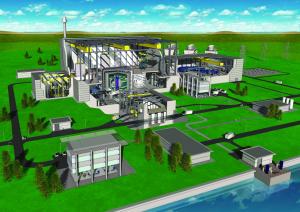Bringing it all together for DEMO
19 Nov 2012
-
Nick Holloway, Culham Centre for Fusion Energy
Experts at Culham Centre for Fusion Energy (CCFE) have carried out the first-ever integrated assessment of the life expectancy of materials in a full-scale fusion power plant design.
The study focused on the effects caused by the build-up of helium in fusion materials. When neutrons from fusion reactions hit the materials in reactor components, they trigger nuclear reactions that cause transmutation (the changing of elements to form new ones). Helium is one of the gases produced by such reactions. The accumulation of helium causes swelling and embrittlement of materials—leading to fracture—and is one of the factors expected to limit the lifetime of components in a fusion power plant.
Materials modellers Mark Gilbert and Sergei Dudarev, working with CCFE specialists in nuclear data and neutron transport (Lee Packer, Jean-Christophe Sublet, and Shanliang Zheng) have conducted a pioneering study in which a fusion power plant design was explored and assessed using an integrated computational model that gives a detailed prediction of the lifetime of components under helium embrittlement.
The results will help guide the choice of materials for the design of DEMO, the prototype power plant that will follow the ITER experiment.
"We found wide variations between the behaviour of different materials," said Mark Gilbert. "The good news is that tungsten (the likely material for the 'divertor' plasma exhaust system in DEMO as well as ITER) shows low susceptibility to helium accumulation and embrittlement. However, in the iron of steels, for example, there is higher helium production in components bearing the brunt of neutrons from fusion reactions. The study highlights the need to develop materials with special microstructure, such as oxide dispersion strengthened steels that can resist the effects of helium accumulation without becoming brittle."
"We think the integrated approach we have adopted has worked well, and it will now help advance the EFDA materials program as a result."
The results of the work are published in Nuclear Fusion 52 (2012) 083019.


